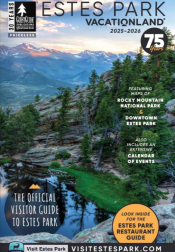Some lakes hold a lot of history and stories amongst their names. Others, are purely descriptive – making it a lot easier to picture in our minds. Check out how some of our favorite lakes in and around Estes got their names.
Sprague Lake
This lake is named after Abner, you guessed it, Sprague - one of the original settlers in the Estes Park area. In 1874, Sprague built a homestead in Moraine Park that was eventually used as a resort for hunting, fishing, dude ranching and even golfing! Around 1900, Sprague moved to Loveland but after ten years found his way back to the mountains. Abner and his wife then built another guest lodge in the Glacier Basin area, which just so happens to be where the current parking area for Sprague Lake is now! And one last fun fact - Abner Sprague became the first visitor to pay an entree fee in 1939. What number visitor do you think you are now?
Bear Lake
In 1912, a man sought out this lake to hunt deer and elk. Unexpectedly, he saw a bear... thus earning it’s pretty obvious name. Nowadays, I wouldn’t expect to see a bear due to its popularity.
Bierstadt Lake
It's namesake… yep, a man named Albert Bierstadt in 1932. Bierstadt was a landscape artist who frequently visited and painted the Rocky Mountains. Before it was Bierstadt Lake though, Native Americans named it “Hanging Lake” due to its perched-like condition.
Ouzel Lake
Ouzel Falls, Ouzel Creek, and Ouzel Lake are all named after a small, grey colored bird called the American dipper. These birds are known for “dipping” along the rocks around fast moving waters and diving down to look for food.
Lake Haiyaha
This lake is surrounded by large boulders with twisted pine trees growing out of the many rock crevices. Haiyaha is a Native American word that translations to “rock,” “big rocks,” or “lake of many rocks.” All of those translations seem to fit pretty perfectly.
Nymph Lake
This magical looking lake is named for the yellow lily, Nymphaea polysepala, that decorates its surface. On your way to Lake Haiyaha, you’ll see Nymph Lake.
Lake Estes
You’ve probably seen this lake, better yet- driven over it as you’ve entered town. Lake Estes was constructed in 1947 and named after Kentuckian Joel Estes and his wife Patsy, who came to Estes in 1864. The name was coined by a publisher of the Rocky Mountain News who stayed with them and was impressed by their hospitality, something that Estes still strives for. Bike, run, walk the Lake Estes loop!
Mills Lake
This lake was named after Enos Mills, the “Father of Rocky Mountain National Park.” In Estes Park, Mills became an innkeeper and homesteader, adventure nature guide, author/speaker and national park advocate. Adventuring in 1889 in California, he met John Muir who worked to preserve Yosemite which became a national park in 1890. Their chance meeting was life-changing for Enos as Muir encouraged him to start observing, writing, and speaking. Muir told him, "I want you to help me do something for parks, forests and wildlife," and Enos did just that! Enos continued to fight to preserve the place he loved for future generations and waged a campaign to see these Colorado mountains protected as a national park, which was won in 1915.
It’s cool to know about the folks who have traveled to these lakes before you, before they were a popular destination in our beloved National Park – maybe it will make your trip more meaningful and you will feel more connected to the place we call home, that’s our hope at least. We also realize that these fun facts could be used as “did you knows” to your friends while you hike to these lakes. That’s cool too!





